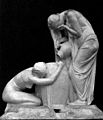Paul Oesten
Paul Oesten (* 1874 in Berlin ; † 1936 in Berlin-Wannsee ) was a German sculptor .
Life
Paul Oesten was first a student of Reinhold Begas and then of Ludwig Manzel at the Royal Academy of Arts in Berlin . During his studies he won the Rome Prize of the Academy with a stay at Villa Strohl-Fern from 1905 to 1906, which gave him insights into classical art. He lived and worked in Berlin , where he was married to Alice Schoeller (* 1890), the daughter of the banker Alexander Schoeller .
Works (selection)
One of the best-known and best-selling works by East is the bronze figure Satyr , which was handcrafted in various sizes by the Gladenbeck art foundry between 1900 and 1910 . The figure shows a young satyrisk or faunus with pointed ears and a tail and often bears the inscription Hereditary burden , which is to be understood ironically with the critical view of the hybrid creature on his tail.
Other works have titles such as Oestens Farewell (1920), Danaids Fountain (Gold Medal at the Great Berlin Art Exhibition 1906), Diana and the Panther , feeding or the driver ( Munich Glass Palace ).
Web links
- Paul Oesten (German, 1874-1936). In: artnet , with pictures of work by Ostens.
Individual evidence
- ↑ a b Oesten, Paul (born 1874), Sculptor. In: Emmanuel Bénézit : Dictionary of Artists . ISBN 978-0-19-977378-7 , 2006.
- ↑ Renting a studio in Rome for scholarship holders of the Academy (Villa Strohl-Fern) - reports on the work, rent payment, etc. The following scholarship holders or guests in Rome: Paul Oesten 1905/1906 Prussian Academy of the Arts (PrAdK 0731)
- ↑ a b Studio International London, Cory, Adams & Mackay 1893, pp. 163-164.
- ↑ Schoeller, Julius Alexander in the German biography
- ^ Bronze figure "Satyr": 1900–1910, Berlin, Gladenbeck, P. Oesten. In: Objects from July 12, 2018, Bares für Rares , ZDF
- ^ Farewell, approx. 1920. In: artnet
| personal data | |
|---|---|
| SURNAME | Oesten, Paul |
| BRIEF DESCRIPTION | German sculptor |
| DATE OF BIRTH | 1874 |
| PLACE OF BIRTH | Berlin |
| DATE OF DEATH | 1936 |
| Place of death | Berlin-Wannsee |



